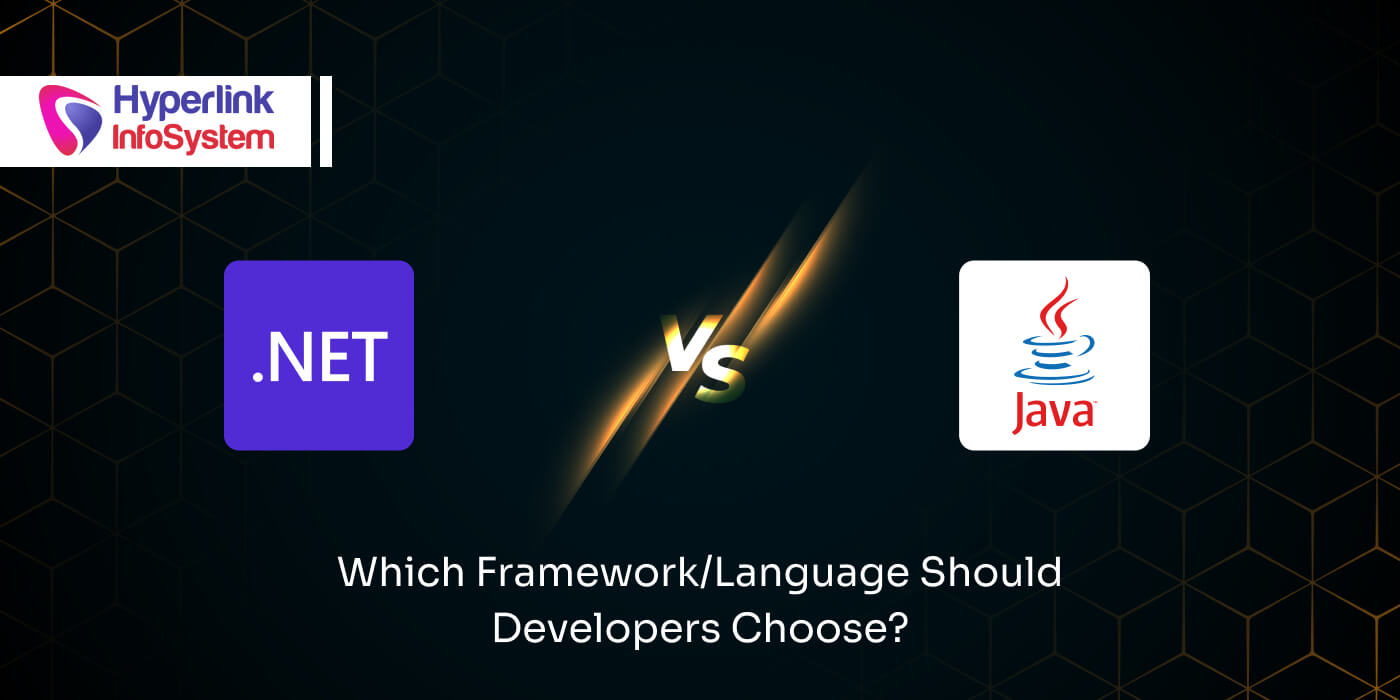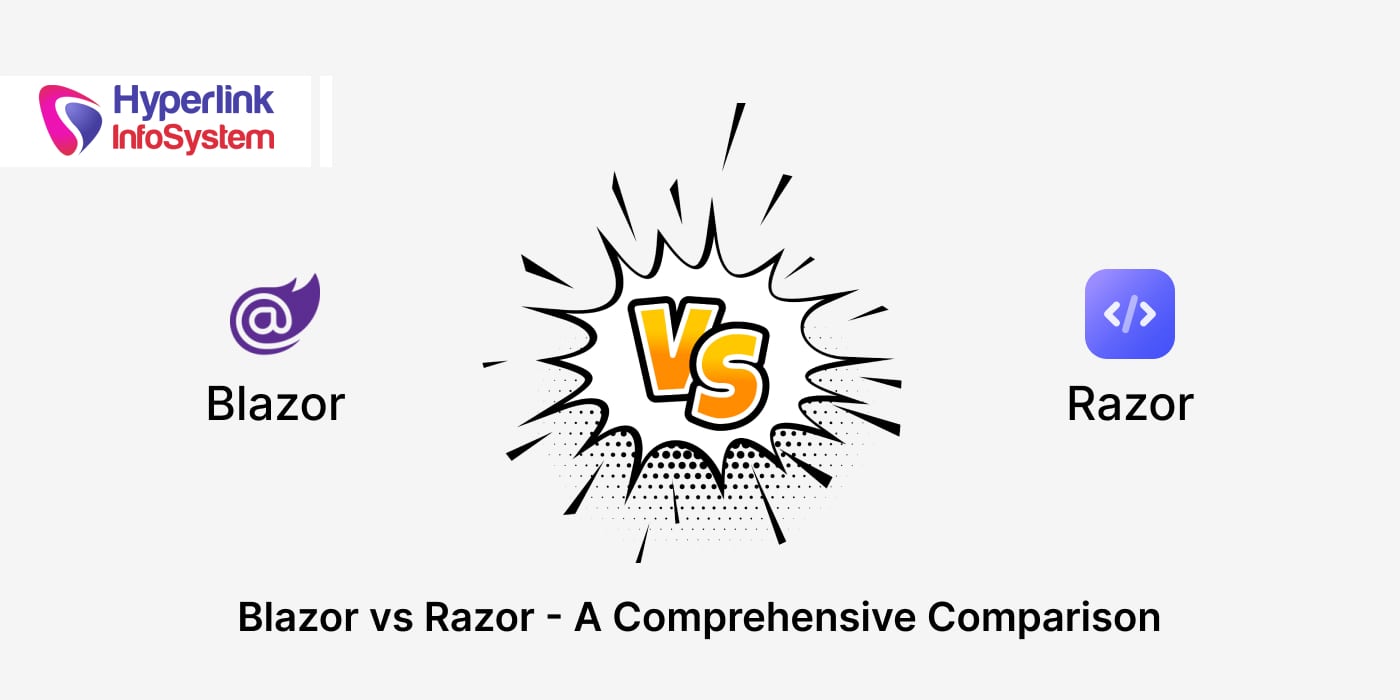.NET Vs. Java: Which Framework/Language Should Developers Choose?
Jul 2025

Choosing between Java and .NET in 2025 is tricky, and things were no different 10 years ago. Java runs on any computer with a JVM, making it perfect for cross-platform development. On the other hand, Microsoft developed .NET and constantly improves it. Similar to Java, .NET has cross-platform capabilities. Java is a popular programming language, and .NET is a framework. Both have similarities, yet they are different. Which programming language to choose and why? This is the essence of our blog.
What Is Java?
Sun Microsystems introduced Java, an object-oriented programming language, back in 1995. One of the standout features of Java is the JVM (Java Virtual Machine), which lets developers write code once and run it on any device of their choice. Thanks to its straightforward syntax and a treasure trove of libraries, Java is the preferred choice for building desktop, web, Android apps, and enterprise systems.
Java was the 7th most commonly used language in 2024. Over 30.35% of developers use it. On the TIOBE Index, Java ranks 4th as of May 2025. Also, 90% of software development companies use Java for their software development needs. Why is Java so popular? The points below highlight the reasons for Java’s popularity.
- Maturity and Stability - First public release in 1993. Known for its reliability in large-scale systems.
- Write Once & Run Anywhere - Java runs on JVM, making it a top choice for cross-platform apps.
- Massive Ecosystem - Tools like Spring Boot, Maven, and Gradle support fast and scalable development.
- Enterprise Adoption - Used increasingly in banks, government institutions, and large enterprise systems.
- Android Development - Java (and now Kotlin) effectively powers Android apps.
- Strong Community - Massive global developer base with thousands of libraries, frameworks, and documentation.
Are you working on a legacy system or looking to build large-scale enterprise applications? Hire Java developers for your project today.
11 Top Features of Java Framework
The key features of the Java programming language are as follows-
- Platform Independent - Write once and run anywhere using the JVM.
- Object-Oriented - At its core, Java is all about object-oriented programming. It capitalizes on classes, objects, inheritance, polymorphism, and abstraction to create ground-breaking applications.
- Fast Learning Curve - Beginner-friendly with familiar syntax, automatic memory handling, and robust community support.
- Platform Independence - Runs on any platform via JVM. No need to rewrite the code.
- Automatic Memory Management - Handles memory allocation and garbage collection automatically for enhanced performance.
- Security - Offers built-in security through JVM, class loaders, and bytecode verification.
- Rich API - Provides a solid, dependable, and vast set of APIs for imaging, media, data, and 3D graphics.
- Multithreading - Supports concurrent thread execution for multitasking, well-suited for games and animations.
- High Performance - Achieves high speed using bytecode, efficient frameworks, and built-in garbage collection.
- Scalability - Scales easily due to OOP principles, efficient resource use, and support for enterprise systems.
- Simplified Syntax - Clean, structured, and case-sensitive syntax that is easy to read and compile.
Pros and Cons of Java Language
Below are the pros and cons of Java in a simple table format.
|
Pros |
Cons |
|
Platform-independent via JVM (write once and run anywhere) |
Verbose syntax increases boilerplate code |
|
Strong memory management and garbage collection |
Slower startup time compared to natively compiled languages |
|
Large standard library and robust frameworks |
GUI development is outdated and clunky |
|
Wide community support and extensive documentation |
Memory usage is higher due to JVM overhead |
|
High performance compared to many interpreted languages |
Not ideal for low-level system programming |
|
Strong type system reduces runtime errors |
Complex generics and type erasure can be confusing |
|
Ideal for large-scale, enterprise-level apps |
Less suitable for rapid prototyping or scripting |
|
Solid support for multi-threading and concurrency |
Performance lags compared to C/C++ in computer-intensive tasks |
|
Back compatibility across versions |
Mobile development has largely been overtaken by Kotlin |
|
Mature ecosystem with numerous tools and IDEs |
JVM dependencies can complicate containerization or lightweight deployments |
What Is .NET?
Microsoft created and launched .NET in 2002 to support Android development. Not only is .NET an open-source software development framework, but it also boasts a comprehensive suite of libraries and tools to build a variety of applications. Whether your goal is to build web and mobile apps, cloud solutions, games, or IoT systems, .NET has something for everyone. In the beginning, it was only a Windows-focused platform, but in 2016, Windows introduced .NET Core, allowing developers to create apps across diverse platforms.
As of now, over 34,698,323 websites run on ASP.NET. Additionally, approximately 21.2% of developers worldwide use the .NET Framework. Even the top 75% of large enterprises use .NET to build scalable and high-performance apps. Below are some points that highlight the reasons for .NET’s widespread usage and popularity.
- Microsoft Backing - .NET receives continuous support and backing from Microsoft.
- Multiple Languages - Supports multiple languages such as C#, F#, or VB.NET.
- Ideal for Windows Apps - Perfect for building apps that run on Windows.
- Cross-Platform Capabilities - .NET Core and newer versions have cross-platform capabilities. It also works with macOS and Linux.
- All-in-One Platform - Enables developers to craft websites, mobile, desktop, web apps, plus cloud services, all with a single toolkit.
Want to build enterprise software that is scalable, secure, and easy to maintain? Hire .NET developers for your project today.
14 Top Features of .NET Framework
The top features of .NET are as follows-
- Cross-Platform Support - Runs on Windows, macOS, and Linux.
- Multi-Language Compatibility - Supports C#, F#, AND Visual Basic.
- Common Language Runtime (CLR) - Handles memory management, exception handling, and type safety.
- Base Class Library (BCL) - Rich set of usable classes, interfaces, and APIs.
- Asynchronous Programming - Built-in support with async/await keywords.
- Language Integrated Query (LINQ) - Query data directly from code with strong typing.
- Garbage Collection - Automatic memory cleanup.
- Just-In-Time (JIT) Compilation - Compiles code at runtime for optimized performance.
- NuGet Package Manager - Streamlined dependency and library management.
- Entity Framework Core - ORM for streamlined database access.
- Integrated Security Features - Comes with built-in support for authentication, authorization, and cryptography to ensure data safety.
- Visual Studio Integration - Advanced IDE support that includes debugging, profiling, and refactoring tools to enhance coding experiences.
- Modular Architecture - Perfectly supports microservices, containers, and cloud-native development.
- Blazor - Allows developers to run C# in the browser using WebAssembly.
Pros and Cons of .NET
Below are the pros and cons of .NET in a simple table format.
|
Pros |
Cons |
|
Extensive class libraries simplify complex tasks |
Mainly limited to the Windows environment |
|
Strong built-in security mechanisms like CAS and validation |
Requires heavy framework installation |
|
Supports multiple programming languages like C#, VB.NET, and F# |
Limited cross-platform capabilities and less flexible compared to .NET Core/.NET 5+ |
|
Seamless integration with Visual Studio |
Slower performance compared to native code due to CLR abstraction |
|
Manage code execution - Automatic memory management via CLR |
Obsolete for new projects - Superseded by modern .NET versions. |
|
Enterprise-level scalability - Suitable for large-scale business apps |
Tightly coupled to IIS - Web apps rely heavily on IIS for hosting |
|
Rapid application development - Tools and frameworks boost development speed |
Legacy dependencies - Some components are outdated or deprecated |
|
Automatic garbage collection - Reduces memory leaks and manual cleanup |
Slower update cycle - Receives fewer updates compared to newer .NET platforms |
11 Key Factors to Consider While Choosing Between Java and .NET
In the above sections, we discussed the differences between .NET and Java. However, choosing between the two requires a detailed understanding of each one’s capabilities. Both .NET and Java are open-source technologies, created to address the rising needs of development companies. Below, you will find the 12 most crucial factors to keep in mind when choosing between .NET and Java.
1) Cross-Platform Development
- .NET
Following the release of Microsoft’s .NET 8, developers can now create applications that run on a myriad of platforms, including Windows, Linux, macOS, and mobile devices. Plus, with .NET MAUI (multi-platform App UI), developers can take advantage of a single codebase to develop apps for multiple platforms and operating systems. This flexibility positions .NET as the top choice for professionals looking to build apps across different environments.
- Java
Java is like a secret weapon for companies aiming to build apps that can run on a broad range of operating systems and devices. The key to this flexibility lies in the Java Virtual Machine. It allows developers to run their code anywhere without having to rewrite or modify it. Java’s write once and run anywhere feature. The written code runs in the same way, regardless of the operating system. Developers save valuable time and effort because they don’t have to create separate apps for each platform.
2) Performance and Scalability
- .NET
Improved AOT (ahead-of-time) compilation in .NET 8 takes the app’s code and converts it into machine code before users can even execute it. This leads to better performance and cuts down on startup time and memory usage. Lower memory usage is a boon in environments like cloud servers, where resources like memory and CPU can be limited.
- Java
As time has gone by, Java’s performance has skyrocketed, thanks to significant JVM upgrades and two new features that rolled out. These features are called Project Panama and Project Loom. The main objective of these two features is to handle multiple tasks simultaneously and connect with code written in other programming languages. Due to its improved interoperability and concurrency, Java is a hot favorite for high-performance apps.
3) Ecosystem and Tooling
- .NET
.NET has a powerful IDE called Visual Studio and a light-weight, cross-platform editor called Visual Studio Code. Together, these offer smart features that make development simpler and more effective. The features are as follows-
- IntelliSense - Like autocomplete for code. Provides useful coding information and guidance.
- Integrated Debugging - Allows developers to run code step-by-step and fix problems without using external tools.
- Azure Integration - This is Microsoft’s cloud platform. With Visual Studio and VS Code, developers can connect the app to Azure services such as hosting and AI tools.
When it comes to enterprise apps, .NET shines. It not only works effortlessly with Microsoft products such as Office, SharePoint, and Azure, but it also provides solid, long-term support. Plus, .NET empowers developers to create secure, scalable, and reliable apps that can keep up with the growing needs of modern businesses.
- Java
Java has been in the game for more than 25 years, and its ecosystem has evolved tremendously, bringing along a plethora of tools. These tools simplify the process of writing, testing, and fixing errors in apps. Some tools are as follows-
- IntelliJ IDEA - Smart code weather, facilitating faster coding with razor-sharp accuracy.
- Eclipse - Powerful tool leveraged by developers, especially for large projects.
- NetBeans - An easy-to-use tool for beginners or inexperienced developers.
These tools, aka IDEs (Integrated Development Environments), ensure developers need not run from pillar to post to find coding tools. On top of that, Java also has ready-to-use libraries and frameworks, which reduce development time (as developers don’t have to write code from scratch). Examples of the same are as follows -
- Spring - Helps build web apps and serves quicker and with enhanced security.
- Hibernate - Facilitates data management and enables Java apps to connect with databases easily.
As a result of these tools and libraries in Java, developers can build advanced apps, enterprise software, and backend systems.
4) Community and Support
- .NET
Being Microsoft’s baby, .NET releases new updates, bug fixes, and features, making it a dependable framework for long-term usage. Owing to its open-source nature, .NET has an enormous, ever-growing community of users adding valuable contributions such as tools and refinements. This added flexibility makes .NET an excellent resource for long-term projects.
- Java
Millions of individuals use Java, adding to the vast and active community. This community constantly enhances Java’s resources, libraries, and frameworks. Whether you want to build a mobile/web app or an enterprise system, you will find a tutorial or tool to complete the project. As it has been in existence for over two decades, Java has earned the trust of leading companies, financial institutions, and government bodies. Quick and easy access to documentation and learning materials simplifies problem-solving.
5) Cloud Integration
- .NET
Azure and .NET are both Microsoft products, making them a perfect team like Batman and Robin. When they work together, building apps becomes simpler and faster. Tools like Azure rule out the need for server management. All developers need to do is run small pieces of code. Azure runs it when required while handling servers, scalability, and performance.
- Java
Apps built on Java’s foundation run smoothly on most cloud platforms, including Amazon AWS, Microsoft Azure, Google Cloud, and more. Also, Java is not confined to a particular cloud service provider. This means that if you wish to switch from one cloud platform to the other, Java makes it possible without having to rewrite/modify code. This portability feature in Java is great for companies that don’t want to be bound to a contract with any cloud service provider.
6) Security
- .NET
When .NET was designed, it incorporated security features from the very basic level, not after encountering problems. This shows their commitment to security. With built-in systems and tools to shield apps from cyberattacks, phishing attempts, malware, and data theft. Some of the key security features in .NET are as follows-
Code Access Security (CAS) - Controls what system resources the code can access, based on its trust level.
Role-Based Security - Grants permissions based on user roles like admin or guest.
Regular Security Updates - Microsoft frequently patches vulnerabilities to ensure optimal app security.
Built-In Cryptography - Provides tools to easily encrypt and decrypt sensitive data.
Secure Communication - Ensures data is safely transmitted using secure protocols like HTTPS.
- Java
Even Java was designed with a strong emphasis on security. Security is a key feature in web apps, banking systems, and enterprise products. Whether it's web apps or enterprise systems, Java’s design includes strong safety features that shield it from online threats and cybercriminals. Some of these safety features are as follows-
Sandboxing - Runs untrusted code in a restricted environment to prevent system intrusions and breaches.
Security Manager - Controls what the code can access, such as files or networks.
Cryptography APIs - Provides the tools to encrypt data and ensure secure communication.
Authentication & Access Control - Verifies users and controls the actions they can perform.
Active Community & Updates - Quickly addresses security issues through regular updates.
7) Cost Considerations
- .NET
.NET is free and open-source with full backing from Microsoft. What does it mean? It means that anyone can download it and build apps without paying a single cent. The best part is that its services are trustworthy, plus it works on multiple platforms such as Windows, macOS, and Linux. However, there is a catch.
Major Catch
Overall, .NET is free, but some of its tools and services come at an extra cost. If you want to access Microsoft’s premium products, they can be hard on the wallet.
Free Features in .NET
- .NET SDKs and runtimes
- ASP.NET for building web apps
- C# compiler and .NET CLI
- Hosting apps on company servers or Linux
Premium Features in .NET
Visual Studio (Microsoft’s Full-Featured IDE)
- Community Edition is free (for individuals or small teams)
- Professional Edition - $45 per user/month
- Enterprise Edition - $250 per user/month
Azure Services - Hosting the app on Azure requires companies to pay an extra cost for cloud resources.
- Java
Similar to .NET, Java is also free and open-source, but not all its versions are free to use. Businesses may get to use some versions for free, while others may cost extra. Below is a concise breakdown of what is free and what is not.
Zero-Cost Version
- OpenJDK is a free and open-source Java version that many companies use.
- Tools like Eclipse, IntelliJ Community, and NetBeans (free IDEs).
- Java-based frameworks like Spring Boot, Apache Struts, etc.
Paid Offerings
- Oracle JDK - This is a free Java version that Oracle maintains and supports. It is free for personal and development use. However, businesses that wish to use it for commercial purposes must opt for a paid subscription. The cost starts at $15 per employee/month. Enterprise support costs extra and includes professional support, updates, and compliance. Companies can choose to partner with Oracle or other vendors for support.
Note that the costs mentioned above are approximate. Consult a service provider for accurate details.
8) DevOps and CI/CD Support
.NET (Especially .NET 8)
Extremely DevOps friendly for the following reasons-
- DevOps Integration - Works seamlessly with GitHub Actions and Azure DevOps for automated CI/CD.
- Build Automation - Code changes can trigger builds, tests, and deployments automatically through GitHub Actions.
- Docker Support - .NET apps can be easily packaged into portable Docker containers.
- Cross-Platform Deployment - Docker ensures consistent app behavior across development, testing, and cloud.
- Kubernetes Ready - .NET apps can scale and run effectively in Kubernetes-managed environments.
- .NET 8 Enhancements - .NET 8 improves build speed, reduces container size, and supports faster startup with AOT.
Java (Especially with Spring Boot)
Java is an excellent fit for DevOps for the following reasons-
- Mature Ecosystem and Tools
Java works seamlessly with many popular tools. We will discuss some of them below.
Jenkins and GitLab for automating build, test, and deployment steps.
Maven and Gradle for product deployment and steps.
Known for their reliability, these tools have been in use for many years.
- Great With Containers
Developers and engineers can package Java apps (especially those based on Spring Boot) into Docker containers.
This makes the apps portable, meaning they can run on any device, including the cloud, without causing any issues.
- Kubernetes-Ready
Professionals like DevOps engineers, developers, and even backend developers can deploy Java apps using Kubernetes.
Spring Boot offers special tools to make it possible for Java apps to run in Kubernetes.
9) AI/ML and Data Science Support
- .NET
ML.NET is an incredible library that lets developers build, train, and deploy machine learning models directly in the .NET framework without having to depend on other languages. It has made giant strides over the years with newly added features and enhanced performance, giving it the upper hand. It also integrates effectively with the following-
- ONNX (Open Neural Network Exchange) - Enables models trained in other frameworks to be used in .NET apps.
- Azure Cognitive Services (AOS) - Provides ready-to-use AI models for speed to text and image recognition. Eliminates the need to train new models.
Downside of .NET
While ML.NET has made spectacular progress over the years, it still lags far behind Python.
Python boasts an extensive ecosystem filled with libraries like TensorFlow, PyTorch, and scikit-learn, making it the preferred choice for machine learning.
Compared to Python, ML.NET does not have an equal number of tools, tutorials, or even community support required for guidance and delivering better results.
- Java
Although Java is not the preferred language for machine learning or AI, it does have some useful tools and libraries.
DJL (Deep Java Library) - Modern library that allows users to leverage deep learning models in Java.
ND4J - Scientific computing library similar to NumPy (in Python) and useful for math and ML operations.
Downside of Java
Compared to Python, Java does not have the same community and tools required for machine learning.
When it comes to writing and testing machine learning models, Java makes it more complex while not offering the required flexibility.
For advanced tasks, Java can run code written in other languages, such as Python or R, to run ML code. Java does this because these languages offer better support and libraries.
10) Mobile and Desktop Development
- .NET
Microsoft’s modern framework, called .NET MAUI (Multi-Platform App UI), enables developers to write a single code and deploy it as a native app on iOS, macOS, Windows, and Android devices.
- Java
Java’s library and GUI toolkit, called JavaFX, is great for building rich desktop applications. That said, Java is no longer the go-to choice for mobile app development, not even for Android. Since 2019, developers have been more inclined to choose Kotlin over Java for Android development. As far as cross-platform mobile apps are concerned, developers now pick Flutter or React Native.
11) Microservices and Serverless Architecture
- .NET
When it comes to building microservices, Azure Functions and lightweight containers make .NET an excellent choice. The latest version, .NET 8, has brought some impressive enhancements, particularly with AOT compilation. This improvement allows for app compilation into native code, leading to quicker app startup times and lower memory consumption. Hence, it is perfect for cloud-native and serverless environments.
- Java
Spring Boot, Quarkus, and Micronaut are frameworks that bring a lot to the table, such as incredibly quick startup times, such as whirlwind startup, low memory usage, and smooth microservices support. GraalVM enhances performance in cloud environments, and the robust tooling makes developers’ lives easier and turbocharges productivity. With the combined might of these two, Java is a clear winner in serverless and distributed environments.
The above points are the main differences between .NET and Java. Understand that both Java and .NET are scalable, mature, and future-proof. It all boils down to your project goals, team expertise, and ecosystem alignment.
When to Choose .NET and Java in 2025
Both .NET and Java have their share of pros and cons. Below are guidelines on when to use .NET and Java.
Use .NET When
- Building cross-platform apps using a single codebase (via .NET MAUI).
- The requirement is tight integration with Microsoft tools (Azure, Visual Studio, and GitHub Actions).
- Need fast startup times and want to restrict memory usage (AOT in .NET 8).
- Developing enterprise apps with an intense use of Windows Infrastructure.
- Security and compliance are top priorities, and Microsoft’s security ecosystem benefits you.
- Deploying Azure Cloud and requiring extensive support.
- Preference is for strongly typed, modern C# with powerful tooling and IntelliSense.
- Targeting mobile and desktop without using third-party frameworks.
- Ensure adherence to green coding practices with efficient cloud performance.
Are you looking to build high-performance, fast, modern, cross-platform apps? Hire .NET developers today.
Use Java When
- Building platform-agnostic, scalable applications that must run anywhere.
- Require mature frameworks like Spring Boot for complex, distributed systems.
- Deploying to multi-cloud environments (AWS, GCP, Azure) with full portability.
- Team has deep JVM expertise and uses Kotlin along with Java.
- Integrating with large-scale legacy systems or enterprise middleware.
- Require advanced microservices support with tools like Quarkus or Micronaut.
- Building international, multi-lingual apps with deep localization requirements.
- Priority is an open-source platform with an enormous developer community.
- Licensing flexibility is a concern, so you opt for OpenJDK or similar free builds.
Want to build cloud-ready, enterprise-scale apps? Hire the best Java developers now.
Development Costs - Java Vs .NET
Below is an elaborate cost comparison between Java and Dot NET. This includes various factors such as infrastructure requirements, licensing models, developer salaries, and more.
|
Cost |
Java (USD) |
.NET (USD) |
Key Notes |
|
Developer Hourly Rate |
$45 - $80 |
$40 - $75 |
Based on US/Europe averages. Rates in Asia and Latin America may be lower ($20 - $40) |
|
Annual Developer Salary |
$95,000 - $150,000 |
$90,000 - $140,000 |
Senior/Lead developers at the high end |
|
Development Tools |
$0 - $2,000 |
$0 - $2,000 |
Java uses mostly open-source tools. .NET may include licenses for premium products such as Visual Studio Pro |
|
Licensing Costs |
$0 (OpenJDK) - $2,500 (Oracle JDK) |
$0 - $3,000 + (for enterprise-grade Visual Studio, SQL Server, etc.) |
Java is mostly open-source, but Microsoft services can cost extra |
|
Monthly Cloud Hosting |
$100 - $2,000 |
$100 - $2,500 |
Depends on the scale. Azure is often the preferred choice for .NET, AWS/GWP for Java. |
|
Third-Party Libraries/APIs |
$500 - $2,000 yearly |
$500 - $2,000 yearly |
Cost is similar for both, depending on usage. |
|
Maintenance & Support |
15% - 25% of the development cost |
15% - 25% of the development cost |
Includes bug fixes, updates, and support |
|
Total Project Cost (6-Month MVP) |
$60,000 - $180,000 |
$55,000 - $170,000 |
Includes 2-4 developers, basic infrastructure, tools, and licenses |
Final Thoughts
As seen in the above blog, Java is not superior to .NET, and vice versa. Java is open-source and universal, while .NET is Microsoft-backed. Android development companies, or those desiring multi-platform flexibility, should opt for Java. On the flip side, .NET offers reliable, enterprise-grade tools and works effortlessly within the Microsoft ecosystem.
Are you looking to hire dedicated developers for your next project? Look no further. Hyperlink InfoSystem is at your service. Whether it's open-source development frameworks or cutting-edge technologies like AI, ML, IoT, and blockchain, we have a large team of professionals, including developers, testers, and other specialists who can handle complex projects from start to finish.
In the past decade, we have completed over 3000 projects, and our 5000+ clients can vouch for our dedication and efficiency. Speak to one of our experts to see what we can do for you.
Schedule a Consultation Today!
Frequently Asked Questions
The outcome of your project is closely tied to the .NET development company you collaborate with. It's not just about achieving the results. Aspects like budget, deadlines, collaboration, and other aspects can greatly influence the process and the results. While choosing the right .NET development company may feel like a mission impossible, following these steps can help ease your journey.
- Technical Expertise in .NET Ecosystem
Check the .NET development company’s expertise.
Tech Stack Mastery - Must have strong experience in .NET/Core/.NET 6+, ASP.NET, C#, and frameworks such as Blazor, Entity Framework, and SignalR.
Full-Stack Capability - Ability to handle front-end and back-end development within the .NET environment.
Integration Skills - Check for experience with REST APIs, gRPC, Microsoft Azure, DevOps, and third-party integrations.
- Relevant Industry Experience
Check if the .NET development company has built solutions relevant to your sector.
Many companies have diverse experience building solutions for healthcare, fintech, logistics, retail, and other industries.
The question is - Does the .NET development company understand the challenges and user experience needs for your sector?
Ask for case studies and a client list. Have department heads speak with the company to understand how they approach each project.
- Track Record and Portfolio
Has the .NET development company delivered success before? Assess the project scope and complexity.
Ideally, the company should have demonstrated success in developing web and cloud-based .NET applications.
Besides portfolio and testimonials, make it a point to check the company’s reviews on LinkedIn, Clutch and other platforms.
- Development Methodology
An ideal .NET development company must follow agile, DevOps, and embrace advanced technologies to ensure transparent and flexible development.
Understand their development methodology by asking the following questions -
Do they use Scrum or Kanban?
How frequently do you release builds or updates?
Do you track project progress using tools like Jira, Trello, and others?
- QA and Testing
Does the .NET development company conduct automated and manual testing right from the start?
The testing techniques should include unit, integration, and regression tests.
Understand their QA process and confirm they have the required professionals, such as dedicated QA engineers, to do the needful.
- Security and Compliance
Security plays a critical role in sectors such as healthcare, finance, and e-commerce.
Ensure that the .NET development company complies with regulations such as OWASP, GDPR, HIPAA, or PCI-DSS.
Additionally, make sure they have solid procedures in place for code security, encryption, and access control.
Do they conduct audits or penetration tests? Confirm this before taking the plunge.
- Team Composition
An ideal .NET development company should have the right team to handle all types of projects. The team should include professionals such as seasoned developers, project managers, QA, and designers.
Every project should have a dedicated PM.
Check for language skills and time zone overlap.
Consider a pilot project to determine the company’s collaboration and project management skills.
- Pricing Model and Flexibility
Before starting the project, talk to the .NET development company and find out about their pricing models.
Whether it's fixed-price, T&M, or dedicated team models, it should align with your company’s goals and requirements.
Request a detailed quote and clarify terms in case of scope changes.
Apart from the above points, the .NET development company must have a proper maintenance and support plan. Look out for red flags such as poor documentation, overpromising, and vague responses to questions.
Following best practices for Java developers results in considerable technical, operational, and business benefits. The best practices for Java are as follows-
- Use Java 17+ or 21 LTS - Adopt modern features like records and sealed classes.
- Prioritize Composition Over Inheritance - Improves flexibility and reduces tight coupling.
- Apply SOLID Principles - Build scalable and maintainable object-oriented systems.
- Use Streams & Optional - Write cleaner, null-safe, and declarative code.
- Use Dependency Injection - Simplify dependency management with Spring Boot.
- Handle Exceptions Properly - Avoid silent failures and log meaningful errors.
- Write Unit & Integration Tests - Ensure reliability with JUnit and Mockito.
- Use Maven or Gradle - Manage builds and dependencies effectively.
- Document with Javadoc - Explain intent clearly using concise comments.
- Optimize JVM Performance - Tune GC, memory, and threading for greater efficiency.
Web and app development companies should follow best .NET practices to ensure improved software quality, robust security, and increased developer productivity, along with actionable monitoring and diagnostics. Below are some best practices for .NET developers.
- Use the latest .NET version for optimal performance and security, and access to new C# features.
- Apply Async/Await correctly for improved app scalability and responsiveness.
- Dependency Injection - Enhance modularity and simplify testing.
- Follow C# naming and style conventions.
- Use Entity Framework code wisely - Avoid N+1 issues while ensuring proper tracking and management of migrations.
- Implement Solid Logging & Error Handling - Capture meaningful logs using tools like Serilog.
- Write Automated Unit Tests - Ensure reliability with xUnit/NUnit and mocking libraries.
- Design for Security - Follow OWASP guidelines and secure identity and access.
- Manage Config with App Settings and Environments - Keep config separate and environment-specific.
Whether it's hiring .NET developers or Java professionals, Hyperlink InfoSystem has the answer to all your development needs. Companies from diverse sectors such as healthcare, retail, e-commerce, manufacturing, and other sectors trust us. What do you think are the reasons? The following points speak volumes about our achievements.
- 12+ Years of Industry Experience
- Over 5000+ Satisfied Clients
- 3000+ Projects in the Last Decade
- Presence in Over 4 Geographies
- 1000+ Professionals, Including Developers
- Flexible Pricing Models
We are more than just an app development company because we emphasize adopting new technologies and exploring new avenues. Our expertise in game development, ML, and AI integration, and adapting to different sectors, is what separates us from the herd. Be it hiring Java developers, crafting visually pleasing and entertaining games, or data management and cybersecurity projects, we have the proven expertise to execute any project.
If a company follows a structured, efficient, and focused hiring process, it can hire the best Java developers while reducing risk and ensuring excellent performance. Below is a checklist to hire the best Java developers for your project.
- Define project requirements to find the right talent with the exact skills for your project.
- Create a job description to attract qualified candidates and filter unusable ones.
- Source candidates to reach a broader developer pool. This can help find the right talent.
- Assess the candidate's technical skills, including core Java expertise and ability to handle real-world scenarios.
- Evaluate the candidate’s coding and problem-solving skills.
- Ask for references to validate the candidate's experience and skills.
- Don’t keep the candidate waiting for too long. Offer the right salary package.
The top Java IDEs in 2025 are as follows-
- IntelliJ IDEA - Premium quality IDE for enterprise Java with cutting-edge features and smart tooling.
- Eclipse - Excellent for hyper-customization, open-source IDE that is perfect for plugin-rich and legacy projects.
- NetBeans - Beginner-friendly IDE with innovative Java support and simple UI tools.
- VS Code - Lightweight, extensible editor that is excellent for multi-language and accelerated Java development.
- BlueJ/DrJava - Simplified IDEs tailored for educating beginners about Java and introductory programming.
The top Java IDEs mentioned above are more than just tools to complete a project. They make a developer’s life easier by providing them with the right set of tools to boost efficiency and productivity. Using these IDEs enables developers to develop bug-free apps. New Java developers may find it difficult to grasp object-oriented concepts. Educational IDEs eliminate this problem by helping them learn the ropes and facilitating a better understanding of object-oriented concepts.
Most importantly, enterprise IDEs handle complex builds, version control, and frameworks seamlessly. This makes enterprise IDEs the preferred option for large-scale and enterprise development projects.
Latest Blogs

Is BlockChain Technology Worth The H ...
Unfolds The Revolutionary & Versatility Of Blockchain Technology ...


IoT Technology - A Future In Making ...
Everything You Need To Know About IoT Technology ...

Feel Free to Contact Us!
We would be happy to hear from you, please fill in the form below or mail us your requirements on info@hyperlinkinfosystem.com
Hyperlink InfoSystem Bring Transformation For Global Businesses
Starting from listening to your business problems to delivering accurate solutions; we make sure to follow industry-specific standards and combine them with our technical knowledge, development expertise, and extensive research.
4500+
Apps Developed
1200+
Developers
2200+
Websites Designed
140+
Games Developed
120+
AI & IoT Solutions
2700+
Happy Clients
120+
Salesforce Solutions

40+
Data Science

















